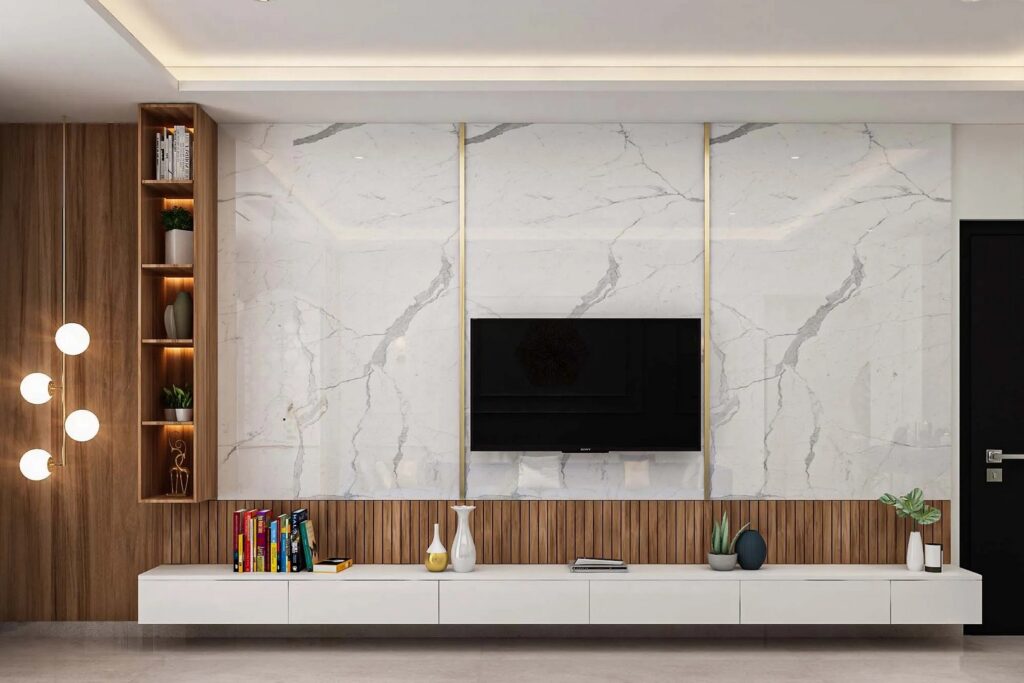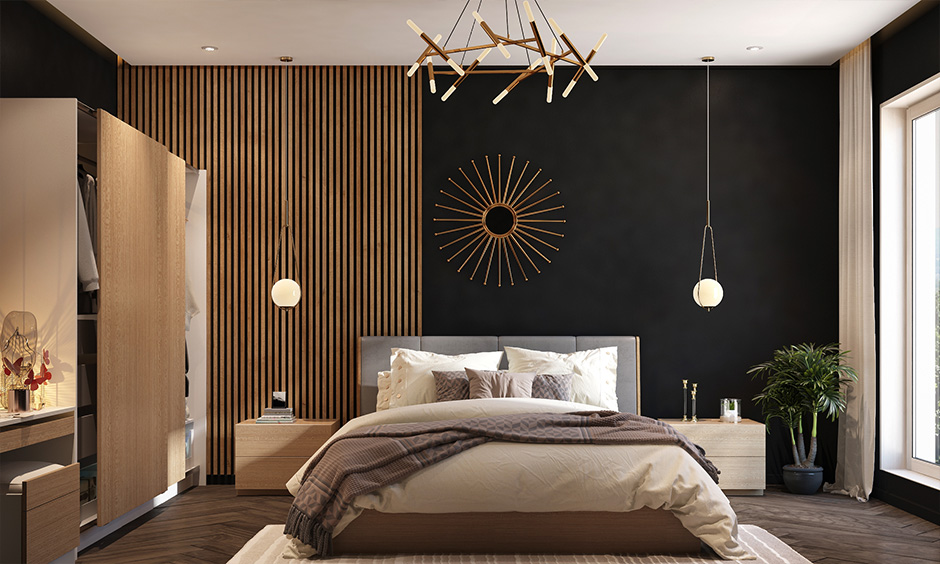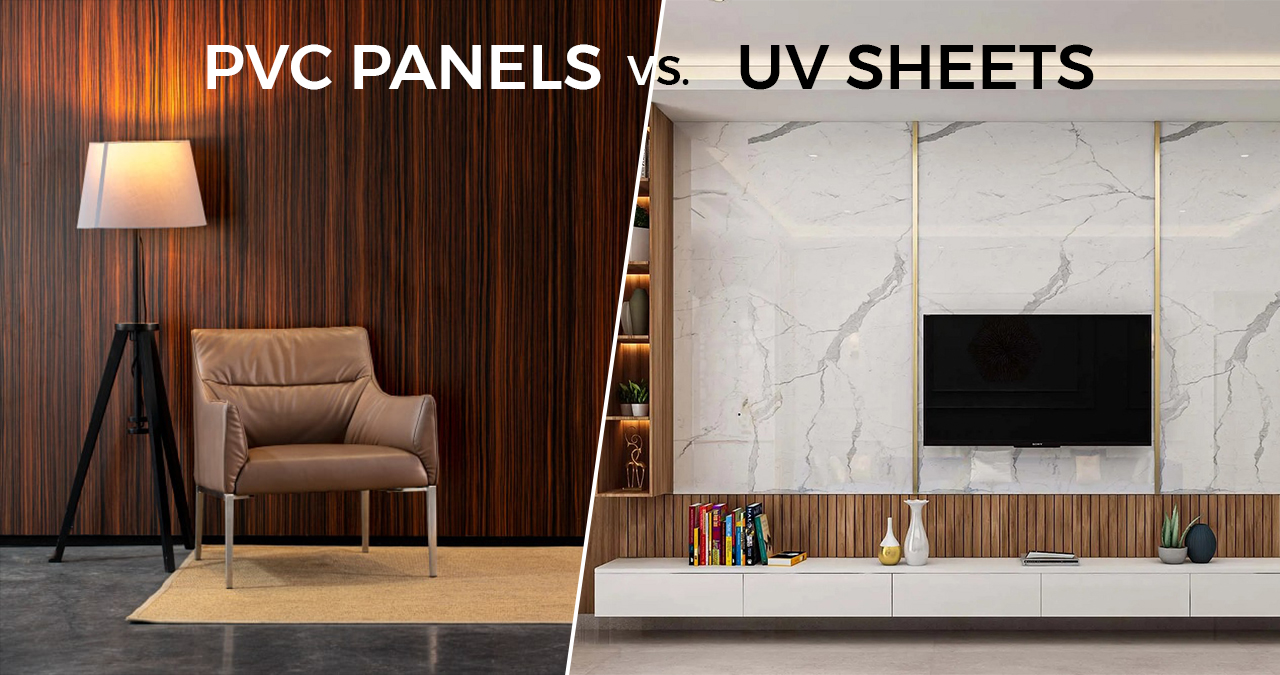There are many ways to change your environment in interior design. Walls are an important component of design that can be decorated with various materials, each with its advantages. PVC panels and UV sheets are two options that have gained popularity recently. However, how can you choose the best one for your project? This thorough guide explores the essential features of PVC panels and UV sheets to assist you in making a well-informed choice.
Understanding UV Sheets

UV sheets are a kind of rigid plastic sheet with a unique UV (ultraviolet) coating. They are sometimes referred to as UV-coated PVC sheets or UV marble sheets. There are numerous advantages to this coating, including:
Enhanced Durability: Suitable for high-traffic locations, the UV coating shields the base PVC sheet from fading, scratches, and wear & tear.
Excellent Gloss surface: UV sheets have a high-gloss surface that gives your room a luxurious, contemporary look.
Enhanced Moisture Resistance: UV sheets are appropriate for bathrooms and kitchens with moderate humidity levels because the UV coating offers protection against moisture.
Wide Range of Designs: You can get the exact look you want with UV sheets because they are available in various designs, such as genuine marble, wood grain, solid colours, and even 3D textures.
Applications of UV Sheets in Interior Design
UV sheets are versatile when it comes to uses in interior design. Here are a few common applications:
Wall panelling: In kitchens, living rooms, bedrooms, and even corridors, UV sheets make an excellent option for accent walls, backsplashes, and full wall coverings.
Accent Pieces for Furniture: Use UV sheets for tabletops, cabinet doors, drawer fronts, and decorative panels to uplift your furniture.
Ceiling Design: Use UV sheets to create an elegant ceiling element. To add a sense of space, choose brighter hues or shiny finishes.
Decorative Pieces: For a dash of contemporary style, create one-of-a-kind wall art, room dividers, or partitions using UV sheets.
Pros and Cons of UV Sheets
Pros:
- Durable and scratch-resistant
- High-gloss finish for a luxurious look
- Moisture resistant for moderate humidity areas
- Wide variety of designs and finishes
- Relatively easy to install and maintain
Cons:
- Can be more expensive than standard PVC panels
- Not suitable for extremely high-traffic areas or direct sunlight exposure
- May not offer the same level of fire resistance as some PVC panels
Understanding PVC Panels

PVC panels are yet another well-liked option for use in interior design. Polyvinyl chloride (PVC), a cheap and lightweight material, is used to make them. A summary of their salient features is as follows:
Cost-effective: PVC panels are a cost-effective solution for covering big spaces because they are often less expensive than UV sheets.
Water Resistant: Standard PVC panels are suited for bathrooms and kitchens with moderate humidity levels because of their strong water resistance.
Variety of Styles: PVC panels provide you freedom in design because they are available in an extensive array of colours, textures, and even wood grain finishes.
Lightweight and Simple to Install: PVC panels are DIY-friendly due to their low weight and simplicity in cutting and installing.
Applications of PVC Panels in Interior Design
These are a useful option for a range of interior design requirements.
Wall panelling: You may use it to create accent walls, cover a complete wall, or install panelling in corridors, living rooms, bedrooms, and even basements.
Ceilings: To give your ceilings a smooth, polished appearance, install it. To provide more visual interest, think about using textured panels.
Bathroom Walls: These are perfect for bathroom walls because of their water resistance, especially in places that aren’t immediately exposed to water spray.
Pros and Cons of PVC Panels
Pros:
- Cost-effective and budget-friendly
- Water-resistant for moderate humidity areas
- Wide variety of styles and finishes
- Lightweight and easy to install
Cons:
- Less durable than UV sheets and prone to scratches and dents
- It may not offer the same high-gloss finish as UV sheets
- Some PVC panels might have lower fire resistance ratings
- Standard PVC panels can fade over time with prolonged exposure to sunlight
Choosing Between UV Sheets and PVC Panels: Key Factors to Consider
Here are some crucial factors to weigh when making your decision:
Budget: Generally speaking, UV sheets are more expensive than PVC panels. Think about your spending limit and your level of willingness to invest.
Desired Look: UV sheets are a better option if you’re going for a glossy, opulent look. PVC panels are a decent option if a more conventional or affordable solution is desired.
Durability: (continued) UV sheets are more resistant to fading and scratches than regular PVC panels. Nevertheless, neither choice works well in regions with a lot of traffic or in the direct sun.
Application: Think about the particular use case. PVC panels and UV sheets can both be appropriate for locations with moderate wetness. Nevertheless, neither is suitable for high-moisture settings such as shower enclosures. Look into using glass or acrylic as substitute water-resistant materials in these spaces.
Maintenance: PVC and UV sheets both require little upkeep. It is sufficient to clean regularly using a moist towel and mild detergent. But stay away from harsh cleaners that can damage the surface.
Fire Safety: This is an important factor to take into account. Verify the fire resistance ratings of the PVC panels and UV sheets you are thinking about. For both materials, some manufacturers have fire-retardant solutions.
Environmental Impact: Examine both choices’ source materials and recyclability if environmental friendliness is an issue. Certain manufacturers provide PVC panels that contain recycled materials.
Conclusion
The field of interior design presents captivating opportunities to realize your vision. Two adaptable choices for decorating your walls and adding gorgeous touches are UV sheets and PVC panels. By being aware of the distinct benefits and constraints associated with each material, you can make an informed decision that fits both the needs of your project and your budget.
Recall that the secret is to put your needs first. UV sheets are the best option if you’re looking for an opulent, high-end look that also happens to be quite durable. Nonetheless, PVC panels offer a strong option if cost and simplicity of installation are your main priorities.
In the end, PVC and UV sheets both present fantastic design options. Examine the wide range of finishes and styles that are available, and don’t be afraid to get expert advice for difficult tasks. You may bring your interior design visions to reality by carefully selecting the ideal material to change your area.

